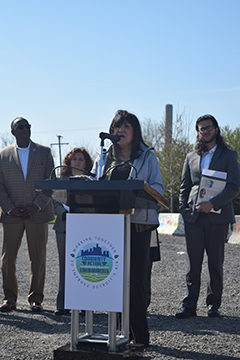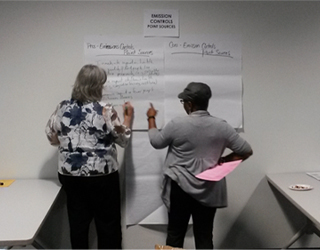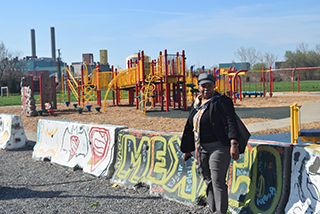Partnerships for Environmental Public Health (PEPH)
Study Location: Detroit, Michigan
Investigators and Co-Investigators:
University of Michigan at Ann Arbor
Amy J. Schulz, Ph.D.
Stuart A. Batterman, Ph.D.
Barbara A. Israel, Dr.P.H.
Natalie Sampson, Ph.D.
Simone Charles, Ph.D.

Launch of the CAPHE Public Health Action Plan at Delray Community Center, Delray People’s Community Services. Pictured from left to right: Guy Williams; Toby Lewis, M.D., University of Michigan; Angela G. Reyes, Detroit Hispanic Development Corporation; and Evan Markarian, Southwest Detroit Environmental Vision. (Photo courtesy of Amy Schulz, Ph.D.)
Laprisha Daniels, M.P.H., M.S.W.
Southwest Detroit Environmental Vision
Raquel Garcia, M.A., M.Ed.
Detroit Hispanic Development Corporation
Angela G. Reyes, M.P.H.
Southwest Detroit Community Benefits Coalition
Simone Sagovac
University of Michigan at Dearborn
Natalie Sampson, Ph.D.
Ecology Center
Kathryn Savoie, Ph.D.
Green Door Initiative
Donele Wilkins
Steering Committee Members:
Theresa Landrum, 48217 Community and Environmental Health Organization
Nick Leonard, J.D., Great Lakes Environmental Law Center
Nicholas Schroek, J.D.
Erin Stanley, M.A., M.S.W., Eastside Community Network
Keisha Williams, Ph.D.
Project Description

Community planning process at the Detroit Center. Pictured from left to right: Barbara Israel, Dr.P.H., University of Michigan Ann Arbor and Rhonda Anderson, Detroit Sierra Club. (Photo courtesy of Amy Schulz, Ph.D.)

Community Center playground adjacent to Detroit Water and Sewerage Facility. Featured in the photo is Rhonda Anderson, Detroit Sierra Club. (Photo courtesy of Amy Schulz, Ph.D.)
Established in 2014, Community Action to Promote Healthy Environments (CAPHE), a community-based participatory research partnership that aims to improve air quality and health in Detroit, Michigan, is taking on a new project. CAPHE builds on long-standing partnerships that engage community residents, community-based organizations, environmental organizations, local and state governments, health practitioners, and academic partners.
The CAPHE public health action plan outlines 25 scientifically based and community-prioritized recommendations to reduce air pollutant exposure and adverse health effects. CAPHE partners are leading advocates for improved air quality and health in Detroit and are working to implement recommendations in the public health action plan. Previous CAPHE efforts have documented air pollutant levels, sources, and distribution; quantified health impacts and inequities; identified mitigation strategies; and projected health benefits of selected strategies.
In this new project, CAPHE researchers and partners are expanding the scope and impact of their longtime efforts through the following specific aims:
- Increase knowledge of environmental exposures and associated health impacts by establishing a community-based ambient monitoring network and data portal for key air pollutants, such as fine and ultrafine particulate matter, organic carbon, and black carbon.
- Use advanced air filtration strategies to improve indoor environmental quality in schools and other child-serving organizations located near major roads and industrial sites with high levels of cumulative risk.
- Engage youth, educators, parents, community-based organizations, and business leaders in air quality research and translation of research to action, and focus on increasing their environmental health literacy, access to resources, and skills working with decision makers.
- Use impact and outcome evaluation to increase the effectiveness, engagement, and impact of actions in the aforementioned project aims.


